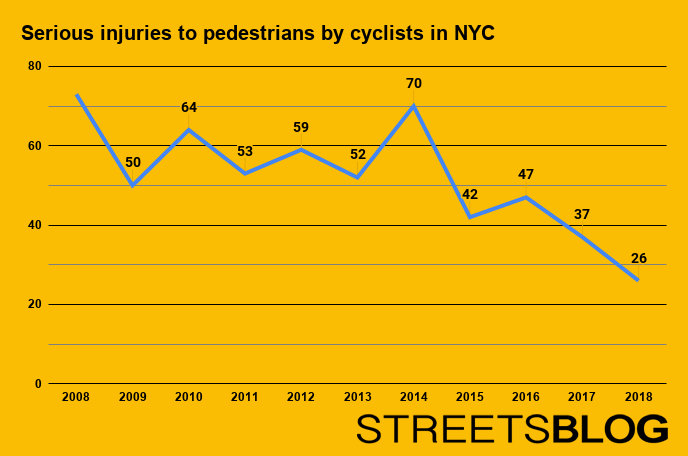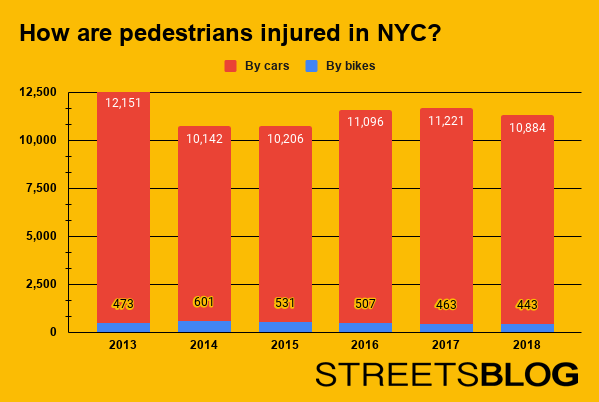Very few pedestrians are being struck and injured by cyclists — and such injuries are dropping dramatically as more and more cities, especially New York, build more protected infrastructure for bike riders.
A new landmark analysis of cyclist-on-pedestrian collisions across the U.S., New York State and New York City between 2005 and 2018 reveals that “pedestrian injuries resulting from collisions with cyclists in the United States and in New York State and city are becoming less frequent,” according to the study, “Recent trends and demographics of pedestrians injured in collisions with cyclists” by Hunter College Sociology professor Peter Tuckel.
And it’s worth nothing that the decline in crashes come during a 14-year increase in cycling and the construction of more protected bike lanes.
Nationally, the number of cyclist-caused pedestrian injuries per 100,000 people dropped from a peak rate of 2.82 in 2007 (before there was virtually any protected bike infrastructure) to .85 in 2016 — a 70-percent decline. (Tuckel uses rates because the population of the U.S. rose from 308 million in 2007 to 324 million in 2016, making the rate-per-100,000 a better measure than raw numbers.)
In New York City, injuries caused by cyclists to pedestrians are also down — from 609 in the 2008 peak year to 443 in 2018, a decline of 27 percent. It is also worth nothing that serious injuries to pedestrians fell from 73 to 26, a drop of 64 percent during the same period (see chart).

The drop in New York is clearly connected to the increase in protected bike lanes, which were basically non-existent in 2008. New York City now has hundreds of miles of protected bike lanes.
There’s been isolated media coverage when a pedestrian is struck by a cyclist, the study points out, and this seems to be mostly because such collisions are so rare. But there really hasn’t been a deep dive on the data until Tuckel’s analysis, published late last year in the Journal of Safety Research.
“The paucity of research concerning pedestrian-cyclist accidents is surprising given the increasing popularity of cycling,” Tuckel writes. “In New York City, for example, there has been an estimated 134-percent increase in daily cycling trips just in the decade between 2007 and 2017.”
If Tuckel is viewed at all by the New York cycling community, it is with suspicion. In 2019, research by him and his students made multiple headlines (not always for reasons Tuckel wanted). Patch’s coverage focused on Tuckel’s finding that some pass through red lights. And the Post used the big font to suggest that many cyclists use their phones while riding.
This report is not likely to generate large tabloid headlines because it confirms a different narrative about cycling — indeed, bike riders are not the menace that some outlets love to portray them as: Cyclist-on-pedestrian injuries are dropping — and if anyone is to blame for them not dropping more, it’s city Department of Transportation officials who have not made roadways safer for all users by building more cycling infrastructure.
Yes, the steepest declines in injuries nationally were in the 0 to 14 age group, largely, the report concludes, because kids are so much more sedentary now, but the biggest factor is road redesigns in the Vision Zero era:

“Improvements in the biking infrastructure provide another explanation for the decrease in injuries stemming from pedestrian-cyclist accidents,” the report states. “Improvements in infrastructure have not only promoted safer cycling but have also enhanced the safety of pedestrians.”
Obviously any injury to a pedestrian is terrible, but to those who would suggest that the report provides ammunition for the anti-cyclist crowed, Tuckel offers a warning: “It should be kept in mind that the danger posed to pedestrians by motor vehicles far outstrips the danger posed to pedestrians by cyclists.”
“As the appeal of cycling both as a recreational activity and as alternative mode of transportation continues to grow, government officials should continue to devote resources to installing protected bike lanes,” he concluded.
In an exchange with Streetsblog, Tuckel also said pedestrians are likely safer now simply because there are more cyclists on the roads.
“The greater numerical presence of cyclists, in general, sensitizes motorists to the fact that they are not the only road users — they no longer have a monopoly on owning street space,” he said. “When motorists become more conscious of the presence of cyclists, they modify their driving behavior so as to accommodate the needs of cyclists. Simultaneously, this behavioral modification benefits pedestrians. As we all know, motorists represent the greatest threat to cyclists and pedestrians.”
We do, indeed.






